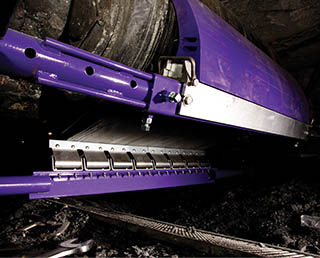The Need for Belt Cleaners by the Numbers
June 19th, 2018
 Maintaining a clean belt is one of the most important factors in the overall efficiency, profitability and safety of a conveyor operation. In spite of all of this, the use of a proper belt cleaning system is still widely overlooked throughout the industry.
Maintaining a clean belt is one of the most important factors in the overall efficiency, profitability and safety of a conveyor operation. In spite of all of this, the use of a proper belt cleaning system is still widely overlooked throughout the industry.
There are many conveyor belt cleaner options to choose from, varying based on the industry or needs of the facility. A precleaner is designed to work where the belt passes over the head pulley and removes a majority of carryback. Secondary cleaners are located further down the line to provide additional cleaning. While some operations employ homemade cleaners, they are typically found to be ineffective, leaving the conveyor system vulnerable to carryback that results in product loss, additional labor hours, downtime, increased safety risks, and wear on the belt and other system components.
To illustrate the importance of a properly installed, professional conveyor belt cleaner, consider the impacts by the numbers:
90%
The expected availability of a thoroughly cleaned and properly maintained conveyor belt. Maintaining consistent uptime is a primary goal of any operation, and a primary benefit of using a belt cleaner.
50%
According to an extensive study of coal handling facilities in India, belts with professional cleaners required only half of the maintenance required of belts without cleaners.
150%
The same study found a correlation between belt cleaners and belt life, with the average belt lasting 150% longer for facilities with professional cleaners compared to those without. Decreased belt life is a result of excessive and premature wear to the belt, its splices, and idlers inflicted by the carryback produced by belts without proper cleaners.
2%
Operations that keep belts cleaned and well maintained can operate with less than 2% unplanned outages due to mechanical or electrical failures.
4 out of 10
Thirty-nine percent of conveyor-related accidents are related to the cleaning or shoveling of fugitive material released all along conveyors without effective cleaning solutions. In addition to reducing man hours and downtime required with manual cleanup, belt cleaners can improve overall operation safety.
60%
After installing a precleaner for a snack food manufacturer, Flexco was able to help limit carryback and reduce scrap losses by 60% compared to the homemade cleaner being used previously.
For the best protection of the conveyor belt and efficiency of the operation, most applications require the use of both a precleaner and one or more secondary cleaners.
A precleaner is mounted on the head pulley, below the material flow with a blade that is always more narrow than the width of the belt. When properly installed, the precleaner can clean off up to 80% of the initial carryback. Complementing the precleaner, a secondary cleaner provides the final cleaning job, removing the sticky fines with cleaning efficiencies up to 90%. These cleaners are typically mounted just past where the belt leaves the head pulley and anywhere down the beltline with a blade the width of the belt or wider.
Conveyor operators have a wide range of factors to consider and model options to evaluate when looking to install a belt cleaner. Consulting with a Flexco professional can help ensure the proper selection, installation, and maintenance of the right belt cleaners for your needs. After considering all of the possible risks to operation efficiency, profitability, and safety without a cleaning solution in place, ensuring the proper use of professional belt cleaners should become priority No. 1 for conveyor operators.
Authored By: Kevin Fales, Product Manager
Fales manages the belt conveyor product (BCP) line, providing product development and engineering with guidance on market requirements for both new product concepts and existing products. He also leads the development of technical and promotional literature supporting BCP line. Fales graduated from Grand Valley State University with a bachelor’s degree in Marketing and is currently working toward his master’s degree in business administration from Western Michigan University.
Subscribe to the Flexco Blog
Published Date
June 19, 2018Product Group
- Belt Cleaning Systems
Issue
- Carryback